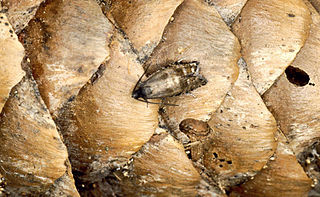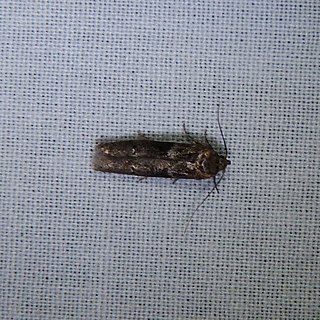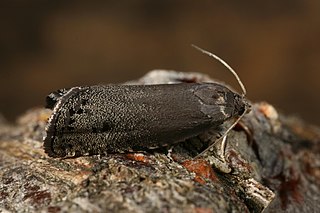
The chestnuts are the deciduous trees and shrubs in the genus Castanea, in the beech family Fagaceae. They are native to temperate regions of the Northern Hemisphere.

The Tortricidae are a family of moths, commonly known as tortrix moths or leafroller moths, in the order Lepidoptera. This large family has over 11,000 species described, and is the sole member of the superfamily Tortricoidea, although the genus Heliocosma is sometimes placed within this superfamily. Many of these are economically important pests. Olethreutidae is a junior synonym. The typical resting posture is with the wings folded back, producing a rather rounded profile.

The codling moth is a member of the Lepidopteran family Tortricidae. They are major pests to agricultural crops, mainly fruits such as apples and pears, and a codling moth larva is often called an "apple worm". Because the larvae are not able to feed on leaves, they are highly dependent on fruits as a food source and thus have a significant impact on crops. The caterpillars bore into fruit and stop it from growing, which leads to premature ripening. Various means of control, including chemical, biological, and preventive, have been implemented. This moth has a widespread distribution, being found on six continents. Adaptive behavior such as diapause and multiple generations per breeding season have allowed this moth to persist even during years of bad climatic conditions.

Cydia is a large genus of tortrix moths, belonging to the tribe Grapholitini of subfamily Olethreutinae. Its distinctness from and delimitation versus the tribe's type genus Grapholita requires further study.

Cydia nigricana, the pea moth, is a moth of the family Tortricidae. It is found in Europe.

Cydia succedana, or Gorse Pod Moth is a species of moth of the family Tortricidae. It is found in Europe and has been introduced to New Zealand.

Cydia fagiglandana, the beech moth, is a moth of the family Tortricidae.

Cydia strobilella, the spruce seed moth, is a moth of the family Tortricidae. It is found in Europe.

Cydia pactolana, the spruce bark tortrix, is a moth of the family Tortricidae. It is found in central, northern and eastern Europe as well as Siberia. In Japan, the subspecies Cydia pactolana yasudai is present.

Acorn moth can refer to either of two small moths whose caterpillar larvae feed on acorns:

Cydia amplana, the rusty oak moth, is a moth of the family Tortricidae. It is found from northern, central and southern Europe to Asia Minor, south-western Russia and Transcaucasus.

Cydia duplicana is a small moth of the family Tortricidae. It is found in all across Europe, extending barely into Asia in the Transcaucasus, Turkestan and Kazakhstan.
Cydia glandicolana is a moth of the family Tortricidae. It is found in China, the Korean Peninsula, Japan and Russia (Amur).
Cydia kurokoi, the nut fruit tortrix, is a moth of the family Tortricidae. It is found in Japan, the Korean Peninsula and eastern China.
Cydia medicaginis, the alfalfa moth, is a moth of the family Tortricidae. It is found in northern and central Europe, Transcaucasus, Kazakhstan and from western Russia to southern Siberia.

Cydia millenniana, the larch gall moth, is a moth of the family Tortricidae which galls larch. It is found from Europe to Russia and the Korean Peninsula.
Cydia zebeana, the larch bark moth, is a moth of the family Tortricidae. It is found in central and eastern Europe, Siberia and China. It is also known from the Netherlands.

Cydia ulicetana is a moth of the family Tortricidae. It is native to western Europe, but was introduced to Hawaii.

Blastobasis glandulella is a species of moth of the family Blastobasidae. It is found in the Eastern United States and southern Ontario, Canada. It has also been recorded in California. In Europe, it has been recorded from Austria, Germany, the Czech Republic, Italy, Slovakia and Croatia.

Cydia inquinatana is a species of moth of the family Tortricidae. It is found in most of Europe, except Ireland, the Iberian Peninsula and the southern part of the Balkan Peninsula. It has recently turned up in the southeast of Great Britain where it may be breeding.
















